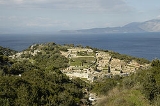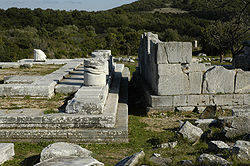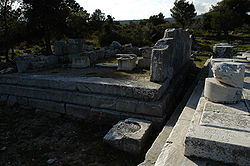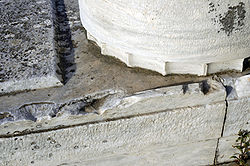
Rhamnous
Encyclopedia
The site of Rhamnous the remote northernmost deme
of Attica
, lies 39 km NE of Athens and 12.4 km NNE of Marathon
, Greece
overlooking the Euboean Strait
. Rhamnous was strategically significant enough to be fortified and receive an Athenian garrison of ephebes (young men). A fortified acropolis
dominates the two small harbors, into which grain was imported for Athens during the Peloponnesian War
. These harbors are located on either side of the fortified hill and have extensively silted up since antiquity. The site was known in Antiquity for its sanctuary of Nemesis
, the implacable avenging goddess whose sanctuary here was the most important one dedicated to her in ancient Greece
. Many grave monuments have been recovered from burials along the road from Rhamnous to Marathon, on which the sanctuary was also sited. Nemesis is the goddess of revenge and balance.
 On the road between Rhamnous and Marathon, around 630m south of the fortified deme site, there was a sanctuary of Nemesis built on a platform with a well-built 44m terrace wall at 38°13'3.88"N, 24° 1'37.07"E. During its time of use the sanctuary was not isolated, but rather was in close proximity to a number of houses and other structures scattered in the vicinity. In the Roman period c. 46 CE, dedications were made to the deified Livia Augusta (wife of Augustus) and to the emperor Claudius. In the 2nd century CE, Herodes Atticus
On the road between Rhamnous and Marathon, around 630m south of the fortified deme site, there was a sanctuary of Nemesis built on a platform with a well-built 44m terrace wall at 38°13'3.88"N, 24° 1'37.07"E. During its time of use the sanctuary was not isolated, but rather was in close proximity to a number of houses and other structures scattered in the vicinity. In the Roman period c. 46 CE, dedications were made to the deified Livia Augusta (wife of Augustus) and to the emperor Claudius. In the 2nd century CE, Herodes Atticus
made dedications of busts of the emperors Marcus Aurelius and Lucius Verus
as well as a statue of his pupil Polydeucion. The cult of Nemesis at Rhamnous came to a formal end with the decree of the Byzantine emperor Arcadius
in 382 CE that instructed any surviving polytheist temples in the countryside to be destroyed.
stone. This temple was probably destroyed by the Persians in 480 BCE. The site of this temple remained in ruins until the larger late 5th BCE temple was built to replace it.
 In the early 5th BCE, a small temple (6.15 by 9.9m) was built immediately south of the ruins of the late 6th BCE temple. Pottery found under the temple dates no later than the early 5th BCE. There are several cuttings on the steps of this temple for the insertion of stelai
In the early 5th BCE, a small temple (6.15 by 9.9m) was built immediately south of the ruins of the late 6th BCE temple. Pottery found under the temple dates no later than the early 5th BCE. There are several cuttings on the steps of this temple for the insertion of stelai
. The temple was built of local dark marble and roofed with terracotta tiles. The walls of the cella and the terrace wall of the sanctuary platform are built in the Lesbian polygonal style of masonry. Based on the dedicatory inscriptions on two marble seats of the 4th century BCE that were sited on the porch, the smaller temple is thought to have been jointly dedicated to Nemesis and to Themis
. This may show that Themis was originally venerated here in conjunction with Nemesis: one the personification of Right Order and the other the avenger of Order's transgressors. This structure survived into the 4th century CE. A statue of Themis and several other dedications, unearthed in the cella
, are at the National Archaeological Museum, Athens
.
 The destroyed late 6th BCE poros temple was functionally replaced by a 6x12 Doric
The destroyed late 6th BCE poros temple was functionally replaced by a 6x12 Doric
peripteral temple in the late 5th century BCE measuring 10.05 by 21.4m. The euthynteria and lowest step of the crepidoma were made from local dark marble, while the rest was constructed of white marble. There were no pedimental sculptures, nor were the metopes
decorated with sculpture. The roof was decorated with sculptural acroteria, however. For unknown reasons the carving of the flutes on the columns was not done. The stylobate blocks were left unfinished, retaining the protective excess marble over their easily damaged corners and upper surfaces.
The cella of the new temple housed the cult figure of Nemesis alone, carved by Agorakritos, a pupil of Pheidias, from the block of Parian marble alleged to have been brought by the over-confident Persians for their triumphal stele
. The famous statue of the goddess stood within the cella of the temple and was around 4m high. The Roman historian and connoisseur Varro
rated it the finest example of Greek sculpture (Pliny). The base has been reconstructed from the hundreds of fragments that were found scattered about after the destruction of the cult image by early Christians. On three sides of the base, the nearly-in-the-round scene shows the presentation of Helen to her mother Nemesis by Leda
. The base was capped with a course of dark Hymettian marble.
 Occupying a c. 28m high hill between two bays, the fortified site of Rhamnous covered a site of approximately 230 by 270m. The fortification walls were constructed of the local marble from Agia Marina. As has been noted above, there were significant numbers of structures and inhabitants outside the walls of the fortified area.
Occupying a c. 28m high hill between two bays, the fortified site of Rhamnous covered a site of approximately 230 by 270m. The fortification walls were constructed of the local marble from Agia Marina. As has been noted above, there were significant numbers of structures and inhabitants outside the walls of the fortified area.
Deme
In Ancient Greece, a deme or demos was a subdivision of Attica, the region of Greece surrounding Athens. Demes as simple subdivisions of land in the countryside seem to have existed in the 6th century BC and earlier, but did not acquire particular significance until the reforms of Cleisthenes in...
of Attica
Attica
Attica is a historical region of Greece, containing Athens, the current capital of Greece. The historical region is centered on the Attic peninsula, which projects into the Aegean Sea...
, lies 39 km NE of Athens and 12.4 km NNE of Marathon
Marathon, Greece
Marathon is a town in Greece, the site of the battle of Marathon in 490 BC, in which the heavily outnumbered Athenian army defeated the Persians. The tumulus or burial mound for the 192 Athenian dead that was erected near the battlefield remains a feature of the coastal plain...
, Greece
Greece
Greece , officially the Hellenic Republic , and historically Hellas or the Republic of Greece in English, is a country in southeastern Europe....
overlooking the Euboean Strait
Euboea
Euboea is the second largest Greek island in area and population, after Crete. The narrow Euripus Strait separates it from Boeotia in mainland Greece. In general outline it is a long and narrow, seahorse-shaped island; it is about long, and varies in breadth from to...
. Rhamnous was strategically significant enough to be fortified and receive an Athenian garrison of ephebes (young men). A fortified acropolis
Acropolis
Acropolis means "high city" in Greek, literally city on the extremity and is usually translated into English as Citadel . For purposes of defense, early people naturally chose elevated ground to build a new settlement, frequently a hill with precipitous sides...
dominates the two small harbors, into which grain was imported for Athens during the Peloponnesian War
Peloponnesian War
The Peloponnesian War, 431 to 404 BC, was an ancient Greek war fought by Athens and its empire against the Peloponnesian League led by Sparta. Historians have traditionally divided the war into three phases...
. These harbors are located on either side of the fortified hill and have extensively silted up since antiquity. The site was known in Antiquity for its sanctuary of Nemesis
Nemesis (mythology)
In Greek mythology, Nemesis , also called Rhamnousia/Rhamnusia at her sanctuary at Rhamnous, north of Marathon, was the spirit of divine retribution against those who succumb to hubris . The Greeks personified vengeful fate as a remorseless goddess: the goddess of revenge...
, the implacable avenging goddess whose sanctuary here was the most important one dedicated to her in ancient Greece
Ancient Greece
Ancient Greece is a civilization belonging to a period of Greek history that lasted from the Archaic period of the 8th to 6th centuries BC to the end of antiquity. Immediately following this period was the beginning of the Early Middle Ages and the Byzantine era. Included in Ancient Greece is the...
. Many grave monuments have been recovered from burials along the road from Rhamnous to Marathon, on which the sanctuary was also sited. Nemesis is the goddess of revenge and balance.
Sanctuary of Nemesis

Herodes Atticus
Lucius Vibullius Hipparchus Tiberius Claudius Atticus Herodes, otherwise known as Herodes Atticus was a very distinguished, rich Greek aristocrat who served as a Roman Senator and a Sophist. He is notable as a proponent in the Second Sophistic by Philostratus.-Ancestry and Family:Herodes Atticus...
made dedications of busts of the emperors Marcus Aurelius and Lucius Verus
Lucius Verus
Lucius Verus , was Roman co-emperor with Marcus Aurelius, from 161 until his death.-Early life and career:Lucius Verus was the first born son to Avidia Plautia and Lucius Aelius Verus Caesar, the first adopted son and heir of Roman Emperor Hadrian . He was born and raised in Rome...
as well as a statue of his pupil Polydeucion. The cult of Nemesis at Rhamnous came to a formal end with the decree of the Byzantine emperor Arcadius
Arcadius
Arcadius was the Byzantine Emperor from 395 to his death. He was the eldest son of Theodosius I and his first wife Aelia Flaccilla, and brother of the Western Emperor Honorius...
in 382 CE that instructed any surviving polytheist temples in the countryside to be destroyed.
Early 6th century BCE temple
The earliest known structure dates to the early 6th century and is known only by its terracotta roof tiles of Laconian type.Late 6th century BCE temple
The late 6th BCE Temple of Nemesis was distyle in antis in plan and built with porosPoros
Poros is a small Greek island-pair in the southern part of the Saronic Gulf, at a distance about 58 km south from Piraeus and separated from the Peloponnese by a 200-metre wide sea channel, with the town of Galatas on the mainland across the strait. Its surface is about and it has 4,117...
stone. This temple was probably destroyed by the Persians in 480 BCE. The site of this temple remained in ruins until the larger late 5th BCE temple was built to replace it.
Early 5th century BCE small temple

Stele
A stele , also stela , is a stone or wooden slab, generally taller than it is wide, erected for funerals or commemorative purposes, most usually decorated with the names and titles of the deceased or living — inscribed, carved in relief , or painted onto the slab...
. The temple was built of local dark marble and roofed with terracotta tiles. The walls of the cella and the terrace wall of the sanctuary platform are built in the Lesbian polygonal style of masonry. Based on the dedicatory inscriptions on two marble seats of the 4th century BCE that were sited on the porch, the smaller temple is thought to have been jointly dedicated to Nemesis and to Themis
Themis
Themis is an ancient Greek Titaness. She is described as "of good counsel", and is the embodiment of divine order, law, and custom. Themis means "divine law" rather than human ordinance, literally "that which is put in place", from the verb τίθημι, títhēmi, "to put"...
. This may show that Themis was originally venerated here in conjunction with Nemesis: one the personification of Right Order and the other the avenger of Order's transgressors. This structure survived into the 4th century CE. A statue of Themis and several other dedications, unearthed in the cella
Cella
A cella or naos , is the inner chamber of a temple in classical architecture, or a shop facing the street in domestic Roman architecture...
, are at the National Archaeological Museum, Athens
Athens
Athens , is the capital and largest city of Greece. Athens dominates the Attica region and is one of the world's oldest cities, as its recorded history spans around 3,400 years. Classical Athens was a powerful city-state...
.
Late 5th century BCE large temple

Doric order
The Doric order was one of the three orders or organizational systems of ancient Greek or classical architecture; the other two canonical orders were the Ionic and the Corinthian.-History:...
peripteral temple in the late 5th century BCE measuring 10.05 by 21.4m. The euthynteria and lowest step of the crepidoma were made from local dark marble, while the rest was constructed of white marble. There were no pedimental sculptures, nor were the metopes
Metopes
Metopes, Op. 29, is a work for piano solo by the Polish composer Karol Szymanowski completed in 1915, which lasts around 15 minutes. It is a cycle of 3 miniature tone poems drawing on Greek mythology. Each of the three movements: "The Isle of the Sirens", "Calypso", and "Nausicaa" features a female...
decorated with sculpture. The roof was decorated with sculptural acroteria, however. For unknown reasons the carving of the flutes on the columns was not done. The stylobate blocks were left unfinished, retaining the protective excess marble over their easily damaged corners and upper surfaces.
The cella of the new temple housed the cult figure of Nemesis alone, carved by Agorakritos, a pupil of Pheidias, from the block of Parian marble alleged to have been brought by the over-confident Persians for their triumphal stele
Stele
A stele , also stela , is a stone or wooden slab, generally taller than it is wide, erected for funerals or commemorative purposes, most usually decorated with the names and titles of the deceased or living — inscribed, carved in relief , or painted onto the slab...
. The famous statue of the goddess stood within the cella of the temple and was around 4m high. The Roman historian and connoisseur Varro
Varro
Varro was a Roman cognomen carried by:*Marcus Terentius Varro, sometimes known as Varro Reatinus, the scholar*Publius Terentius Varro or Varro Atacinus, the poet*Gaius Terentius Varro, the consul defeated at the battle of Cannae...
rated it the finest example of Greek sculpture (Pliny). The base has been reconstructed from the hundreds of fragments that were found scattered about after the destruction of the cult image by early Christians. On three sides of the base, the nearly-in-the-round scene shows the presentation of Helen to her mother Nemesis by Leda
Leda (mythology)
In Greek mythology, Leda was daughter of the Aetolian king Thestius, and wife of the king Tyndareus , of Sparta. Her myth gave rise to the popular motif in Renaissance and later art of Leda and the Swan...
. The base was capped with a course of dark Hymettian marble.
Rhamnous deme site


